MaryAnn Bernal's Blog, page 221
November 7, 2014
25th Anniversary - Berlin Wall Deconstructed: From barbed wire to Death Strip
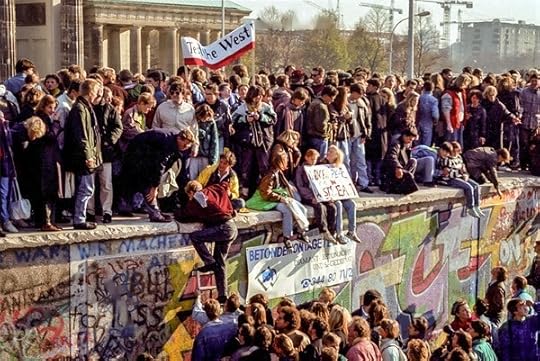
RT's Egor Piskunov follows the evolvement of the Berlin Wall from barbed wire to an almost impenetrable barrier as the world marks the 25th anniversary of its fall.
HERE 25 things you probably didn’t know about the Berlin Wall - http://on.rt.com/szph39
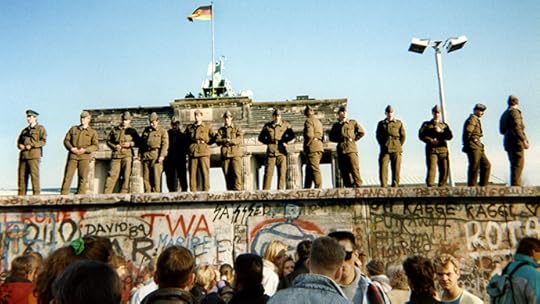
East German border guards stand on a section of the Berlin wall with the Brandenburg gate in the background on November 11, 1989 in Berlin. (AFP Photo / Gunther Kern) It's one the most potent symbols of the 20th century, which fell exactly 25 years ago. But how much do you know about that great divider, the Berlin Wall?
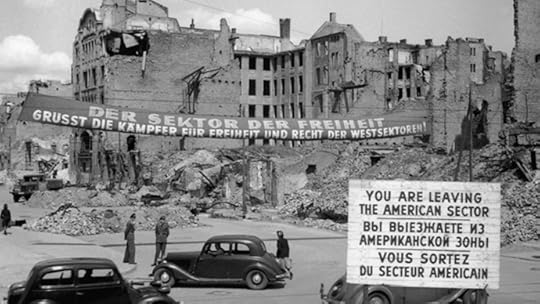
Berlin, straight after the partition in 1945 (image from www.history.co.uk)
1. More than 3 million East Germans escaped to West Germany between 1945 and 1961, most of them through the 'loophole' of Berlin, as the GDR gradually strengthened its borders and restricted travel for its citizens. This was nearly a fifth of GDR’s population, and predominantly the youngest, most dynamic and best-educated class.
Moscow was not pleased, and the future Soviet leader Yury Andropov chided the GDR leadership for not being able to “speak the language of the intelligentsia.”
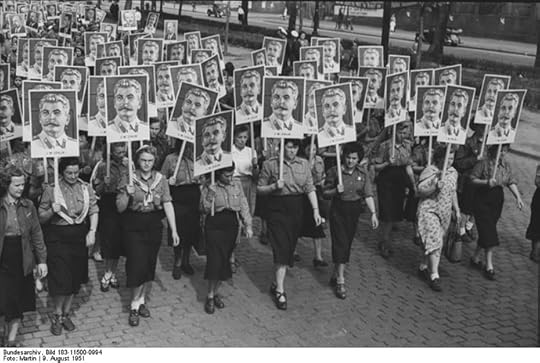
German students carry posters of Joseph Stalin for a youth parade in 1951 (image from wikimedia.org)
2. 50,000 Berliners – known as Grenzgängers – crossed each day to work in the West, receiving larger salaries, while living in subsidized housing, and not contributing to the Eastern economy. Yet that wasn’t the biggest loophole. Due to its power to purchase a wider range of consumer goods, the Western Deutsche mark was worth four to six times as much as the Eastern Deutsche mark. But basic goods, intentionally subsidized within the Socialist economy, and the desirability of the Western currency made the difference even more noticeable. This meant that not only Grenzgängers but also ordinary West Berliners, could exchange their money on the black market, and easily shop for what seemed like ludicrously cheap Eastern goods, as long as they didn’t want to buy Adidas shoes, or Volkswagen cars.
.

The official GDR celebration of 25 years of the "Anti-Fascist Rampart" (Image from bukarest.diplo.de)
3. But there was ideology too. Imagining West Berlin in the middle of Communist heartland, would be comparable to seeing half of Seoul transported to the middle of Pyongyang, or half of London into Tehran. The comparison was astonishing and illustrative of the strengths and weaknesses of each regime. The very existence of a more prosperous and desirable city on their doorstep chaffed at the East German leadership. It's perhaps more surprising that the two parts of the city co-existed peacefully for as long as they did, as the Cold War intensified. But an ideological framing was still necessary. The Berlin Wall was termed the Anti-Fascist Protective Rampart, aimed at preventing enemies from entering Berlin.
"No one should think we are in love with the Wall; that is by no means the case… The anti-fascist protective rampart was necessary to stand up to the military adventurers," explained Walter Ulbricht, the following year. Of course, the purported invaders were still allowed to enter East Berlin throughout most of the Wall’s existence, while East Germans faced the watchtowers, and the barbed wire.
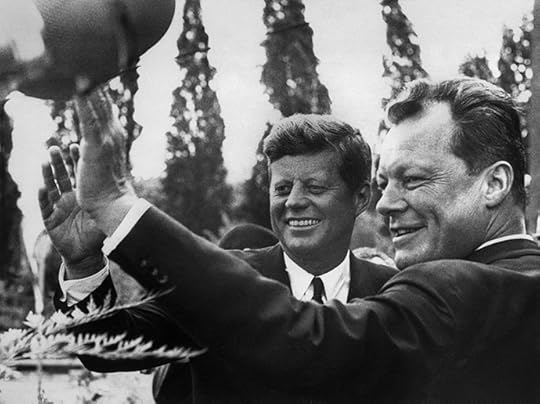
US President John F. Kennedy (left) and Mayor of West Berlin Willy Brandt wave to the crowd during the president's visit, on June 26, 1963. (AFP Photo)
4. On the other side, Willy Brandt, the Social-Democratic mayor of Berlin, and soon to be chancellor, christened the construction the 'Wall of Shame.' The term quickly caught on with the Western media.
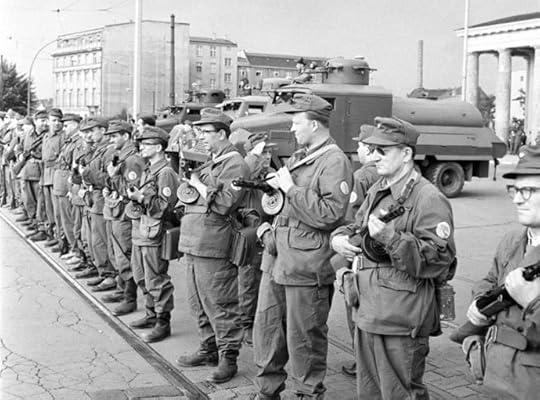
East German Combat Groups of the Working Class close the border on August 13, 1961, in preparation of the Berlin Wall's construction. (wikipedia.org/German Federal Archive)
5. While the world powers were tangled in myriad geopolitical negotiations and ultimatums about the future of Germany and the status of Berlin, the wall was conceived quietly, with documents showing the exact plans were announced to GDR senior party members less than a week in advance.
On August 13, 1961, people on both sides of Berlin woke up to see the entire perimeter sealed off, with work to erect a more permanent divide in full flow. Two despondent crowds looked on, with those in the East realizing now there was no escape, while those facing them from the West held placards and shouted slogans to no effect.
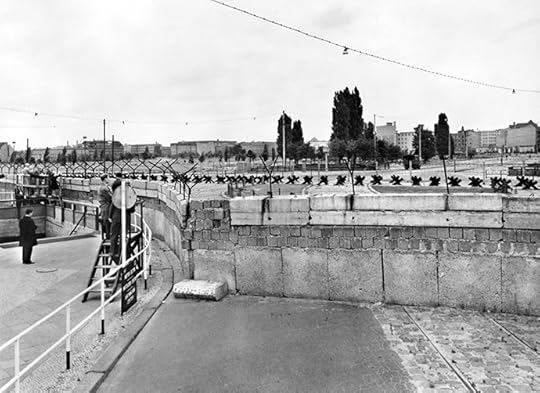
1961, the Potsdamer Platz section of the Berlin Wall. (AFP Photo)
6. Here are some quick stats about the Wall, near the end of its lifetime in 1989. Total perimeter: 155km. Electric contact or signal fencing: 127.5km. Observation towers: 302. Dog runs: 259. Bunkers: 20, guarded by more than 11,000 soldiers.
7. In fact the Wall was not built as a single pre-conceived structure, but a series of four different walls, starting with two wire fences, and then with two concrete walls. The last of these, the iconic Grenzmauer 75, was made up of the graffiti-adorned (on the Western side) concrete blocks that are still commonly associated with the Berlin Wall.
Grenzmauer 75 was also strategically weakened in certain places, in case the Soviets needed to drive their tanks through to the Western side.
8. The so-called Death Strip, which was carved out from East Berlin, varied from 30 to 150 meters in width. Under the blinding floodlights, as well as soldiers and dogs, there were several lines of inanimate obstacles. Among them, signal wire, barbed wire, and a bed of nails. Further along was a trench and anti-tank ‘hedgehog’ traps, in anticipation of a wider conflict. There were also frequently-raked sand strips, which helped the guards identify if anyone – either an insider or a citizen - had attempted to cross unnoticed.
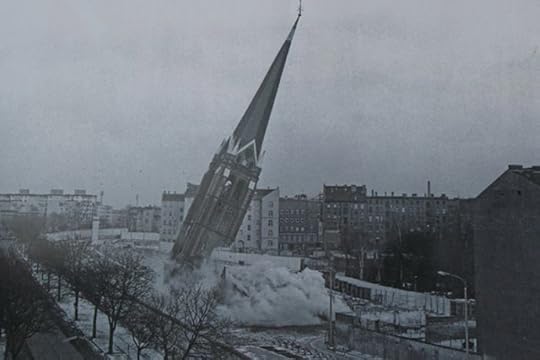
The demolition of the Church of Reconciliation in 1985
9. Inside the Wall was also the ironically-named 19th-century Church of Reconciliation. After the split, the building, whose worshipers had predominantly come from West Berlin, ended up in the Death Strip, leaving only the state atheist military guards of East Berlin as its congregation. Deciding that the hulking, empty building obscured sightlines from nearby watchtowers, GDR authorities ordered the church to be dynamited in 1985.
After the fall of the Wall, a new, modernist building was constructed in the old location, which has become one of the landmarks of unified Berlin.

Gunter Litfin (Image from wikipedia.org)
10. Gunter Litfin was the first person to be shot while trying to cross from East to West, on August 24, 1961. An apprentice tailor and a member of the center-right CDU, illegal in the East, Litfin had already been working in West Berlin, and even rented a flat there. But after his father died earlier that year, he decided to postpone his full-time move to support his family, as defectors were not allowed back. It was a fatal mistake.
Litfin was profoundly shocked when he realized that his life, job and house had been sealed off. Like many in the first few weeks after the construction began, he simply hoped to break through with a well-timed run through what he thought was a poorly-guarded part of the barrier. But when he attempted to climb through some railway tracks, he was spotted by the transport police, and after repeated warning shots, killed by a bullet to the head.
The Eastern authorities initially hushed up the death, and then, after rumors began to spread, claimed that Litfin was a homosexual nicknamed “Dolly”, who was fleeing due to his “criminal acts.”
For the West, he also became a symbolic figure – an innocent victim of the “GDR’s man hunters.” And one of 136 people, who died crossing the Wall, with the last crashing in a self-made balloon less than a year before the wall came down.
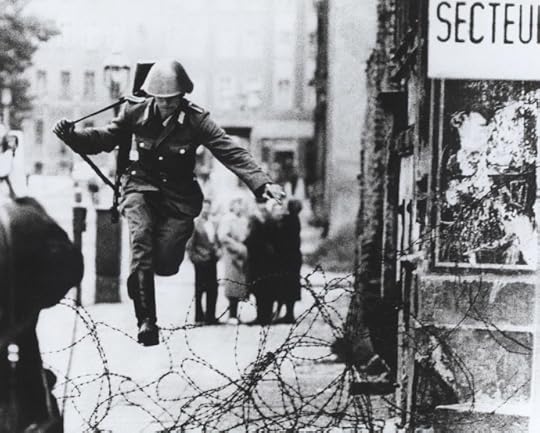
Conrad Schumann escaping across the barbed wire (Image from flickr.com/The Central Intelligence Agency)
11. The guards on the Wall were themselves not averse to taking the few necessary steps to the Promised Land, when no one was looking. In the first two years of its existence, before walls and locks needing several people to open them were installed, more than 1,300 GDR uniformed men defected.
This was undoubtedly a propaganda coup for the West, as iconic photos, like that of 19-year-old Conrad Schumann hurdling the barbed wire, gun still slung across the shoulders, flooded the media on a daily basis.
Gradually, as well as installing sophisticated security mechanisms, GDR officials began to entrusting only the most loyal soldiers with the responsibility of guarding the Death Strip.
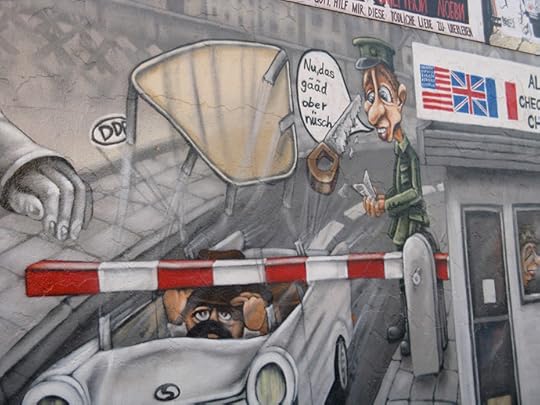
A mural dedicated to Heinz Meixner's escape in Berlin (Image from placetobe.info)
12. In total, about 5,000 people are thought to have escaped through the Berlin Wall during its existence, out of an estimated 10,000 who tried.
For years, stories of daring escapes became a fixture in the Western media, part black comedy, part triumph of human ingenuity and perseverance. There was Horst Klein, an acrobat who dangled off a disused high-tension cable as he made his way to the West inch-by-inch. Heinz Meixner famously cut out his windshield and ducked underneath the drop bar at Checkpoint Charlie, as his car raced away with his mother in the trunk. The ultimate symbols of escape were Hans Strelczyk and Gunter Wetzel, who constructed a functional balloon to fly themselves to freedom in 1979.
These, however, were the low-odds, or one-off scenarios, for the truly desperate risk-takers. Most of the successful defectors probably used bribes, forged documents or connections to sneak out of the East through Checkpoint Charlie – more Argo than The Great Escape.
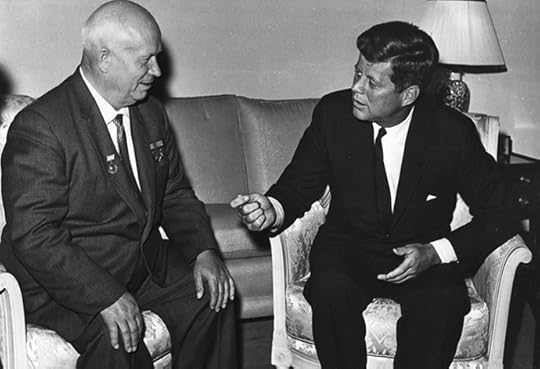
John F. Kennedy (R) and Nikita Khrushchev in 1961. (Image from wikipedia.org/Photograph from the U.S. Department of State in the John F. Kennedy Presidential Library and Museum, Boston.)
13. Despite his Cold War credentials, John F. Kennedy’s reaction to the Wall was muted at best, and he batted away the more gung-ho suggestions that Western troops should bring down the Wall from their side.
“We could have sent tanks over and knocked the Wall down. What then? They build another one back a hundred yards? We knock that down, then we go to war?” his inner circle later reported him as saying.
If anything, Kennedy was relieved that the Wall meant that the Soviet Union no longer had any designs on Berlin, something that had seemed a possibility, since the USSR possessed a huge numerical advantage, and Soviet leader Nikita Khrushchev earlier demanded that the West move its troops out of the city.
“Why would Khrushchev put up a wall if he really intended to seize West Berlin? There wouldn’t be any need of a Wall if he occupied the whole city. This is his way out of his predicament. It’s not a very nice solution, but a Wall is a hell of a lot better than a war,” said JFK, according to biographers’ interviews with his aides.
14. Yet Kennedy keenly realized the importance of the Wall as a vivid propaganda tool that starkly contrasted life in the East and West – perhaps an even better one than the divided, but open, Berlin had been. A triumphant visit to the city, two years after the barrier went up, also led to the impassioned rhetoric of one of his most iconic speeches, delivered in front of several hundred thousand people.
“Two thousand years ago, the proudest boast was 'civis romanus sum' [I am a Roman citizen]. Today, in the world of freedom, the proudest boast is 'Ich bin ein Berliner!'... All free men, wherever they may live, are citizens of Berlin, and therefore, as a free man, I take pride in the words 'Ich bin ein Berliner!'" boomed the US President in front of a crowd that later renamed the square where the speech was made after JFK.
15. The Berlin Wall was also the backdrop for perhaps the most iconic speech of another US President, Ronald Reagan, on the occasion of the city’s 750th anniversary.
“We welcome change and openness; for we believe that freedom and security go together, that the advance of human liberty can only strengthen the cause of world peace. There is one sign the Soviets can make that would be unmistakable, that would advance dramatically the cause of freedom and peace. General Secretary Gorbachev, if you seek peace, if you seek prosperity for the Soviet Union and Eastern Europe, if you seek liberalization, come here to this gate. Mr. Gorbachev, open this gate. Mr. Gorbachev, tear down this wall!” said Reagan.
The speech wasn’t given its due significance at the time, and is known more for symbolizing the direction of the Cold War, rather than for any effect it had on the Soviets, who were bemused by its hectoring tone, at a time when they were already making concessions.
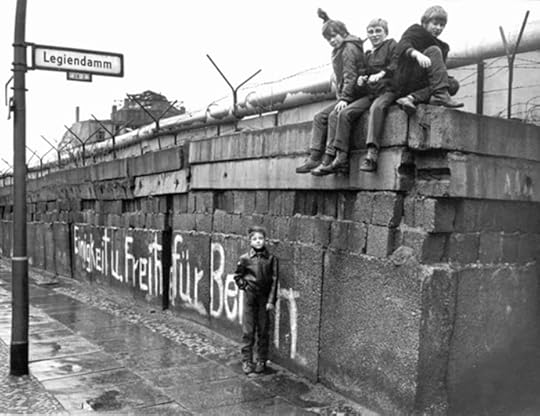
Image from germany.info
16. In fact, by 1989 the fall of the wall itself was as much a symbol of changes that were already happening, as a practical step in the reunification of Germany and the end of the Cold War.
The Berlin Wall largely stopped serving its function as soon as the first leak sprung in the Iron Curtain in Hungary earlier that year, when it opened its borders with Austria, first symbolically and then literally. Like captains of a sinking ship with unsealed compartments, the East German leaders tried to prevent their fellow citizens from leaving through a series of plugs to legal loopholes that only demonstrated their growing impotence. Longtime GDR leader Erich Hoenecker was forced out in October, and in November there had been 500,000-strong demonstrations in Berlin. Egon Krenz, the makeshift leader, ordered for the farce to be stopped, and for Germans to be allowed through.
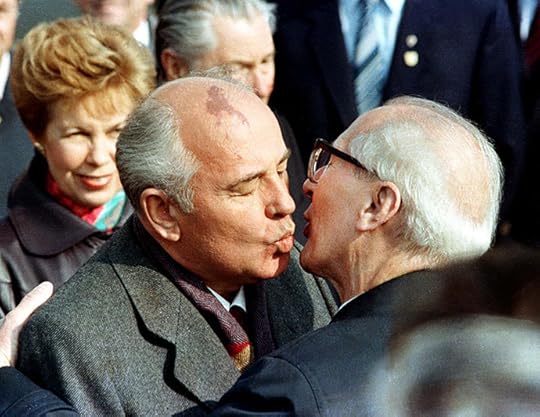
Soviet Leader Mikhail Gorbachev and his wife, Raisa, are welcomed by East German Leader Erich Honecker (R) with a kiss in East Berlin, celebrating the 40th anniversary of East Berlin, October 6, 1989. (Reuters)
17. Mikhail Gorbachev, the target of Ronald Reagan’s calls, was, by all reports, peacefully sleeping in Moscow, when the wall fell. Gorbachev himself had witnessed the Soviet intervention in Czechoslovakia in 1968, and had no intention of invading Eastern Europe. He had already warned Hoenecker he was not in step with the times.
During a visit to West Germany earlier that year, the Soviet leader also declared that every nation can "freely choose its own political and social system" and that Moscow would "respect for the right of all peoples to self-determination."
Additionally, Gorbachev and US leaders held talks that summer, in which the West promised economic support to economically-troubled Moscow, if the Soviet Union did not interfere with the breakdown of Eastern Europe.
18. The Berlin Wall ceased to exist by accident. Günter Schabowski, the spokesman for the collapsing German regime, announced a liberalization of the travel regime – people would no longer have to give a reason to leave - in a press conference at 6:53pm on November 9, 1989. When asked when the regulations would come into force, he uttered “Immediately!”
Later that evening, the GDR government would attempt to backtrack, and call for people to form an orderly line at the migration office the following morning. By then it was too late.
The media on the Western side, which had broadcast Schabowski’s press conference live, jumped on a literal interpretation of the news, as did thousands of people on either side of the border.
19. While most of the checkpoints were taken down by Easterners, there were as many Westerners on the other side, also defying the overwhelmed and befuddled border guards.
To avoid the crush, the officials began to gradually let people in, before losing control, and simply opening the gates.
After sitting inactive for 28 years, troops stationed at the Wall were put on full alert, but no one gave the order to shoot – likely unenforceable – and they stood down later in the night, with some joining the revelers.
20. David Hasselhoff did not bring down the Berlin Wall, nor was he even there on that night, despite what may or may not have been a half-joking lament by the Baywatch star, when years later he complained that he had not been included in the history museum at Checkpoint Charlie.
The singer did capture the mood of the West German public with his hit, Looking for Freedom, in the summer of 1989. But for all of his self-aggrandizing blather, Hasselhoff’s iconic performance on the Wall in an LED-covered jacket happened only in December that year. The part-German star remained a popular performer in his ancestral homeland throughout the 1990s.
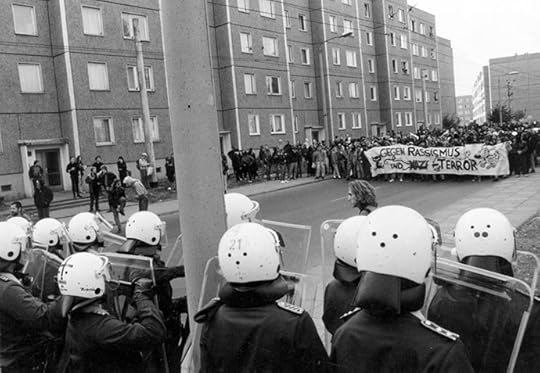
Race riots in Hoyerwerde, former East Germany, in 1991 (Foto: corto/Umbruch Bildarchiv)
21. While the exuberance of the fall of the Wall and the prospects of Western economic wealth could have been expected to spur on new matrimonial unions and produce a baby boom, that was not the case. Exactly nine months after the Berlin Wall was freely traversed, birthrates in East Germany fell by 40 percent and did not recover until 1994, as people underwent a personal and economic transition that predictably failed to match the euphoria of the first few hours.
This was a seismic shift for the sheltered and largely indoctrinated East German population.
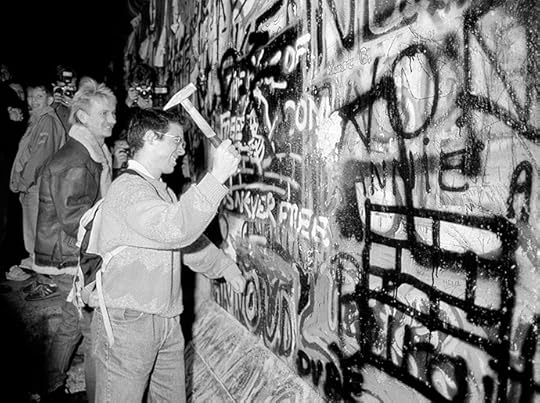
A man hammers a section of the Berlin Wall near the Brandenburg Gate after the border opening was announced, November 9, 1989. (Reuters / Fabrizio Bensch)
22. Within hours of the Wall’s opening, and for the whole of the following year, Mauerspechte, or Wall-peckers, appeared with hammers and chisels, trying to chip away a piece of history for themselves. The wall may have been covered by mostly sloppy graffiti, and its inner chunks may have been indistinguishable from any industrial-site debris, but in its death, it endowed tens of thousands with a physical piece of history.
Symbolic slabs have been given to some of the world’s top museums and universities, sometimes covered in art painted on after the fall, but before the demolition, and frequently behind glass, with a respectful plaque nearby. Perhaps the most playful use of the Wall segments is in the men’s toilets at the Main Street Station Casino in Las Vegas.
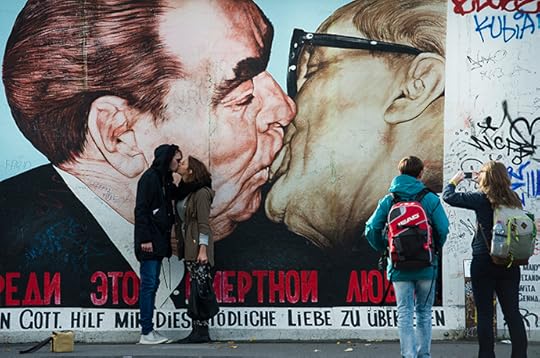
Tourists mimic a kiss in front of a likeness of that between then-Soviet leader Leonid Brezhnev (L) and East Germany's Erich Honecker at the East Side Gallery, a stretch of the Berlin wall, in Berlin (AFP Photo / John Macdougall)
23. Today, only several small stretches of the Wall remain at the original Berlin sites. One has been turned into one of the world’s biggest street art exhibitions. Another tells the history of the wall in signposts. A symbolic trail of cobblestones also runs through the path of the wall, though it is not continuous, and has been built over in many places over the past two-and-a-half decades.
A German group wants to rebuild a whole segment of the Wall, including the Death Strip, as a historical attraction, in the vein of Auschwitz, but plans have not so far come to fruition.

The Border of Lights display (Photo: christopherbauder.com)
24. Aware of the gradual disappearance of the wall as a tangible artifact, for the 25th anniversary, two German artists, the Bauder brothers, have decided to recreate the Wall with 8,000 illuminated balloons, lined up along its landmark segments. On November 9, these will be simultaneously released into the night sky, to mark the liberation of East Germans.
“We place ourselves in solidarity with those who have raised their voices for freedom, democracy, and human rights back then as well as now. And we take a look at the contemporary world in which Berlin, after 25 years, has become a place of creativity, openness to the future and other countries,” Klaus Wowereit, mayor of Berlin, said of the symbolism of the celebration.
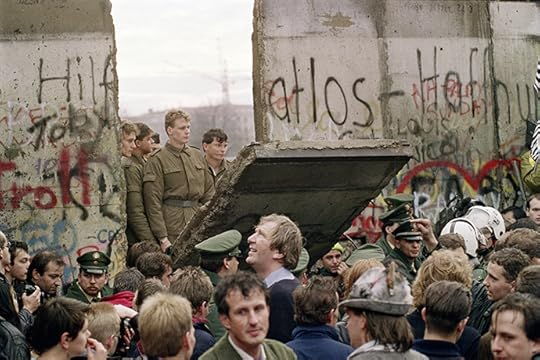
November 11, 1989. West Berliners crowd in front of the wall watching East German border guards demolish a section to open a new crossing point between East and West Berlin, near the Potsdamer Platz. (AFP Photo / Gerard Malie)
25. In a survey conducted last month, three-quarters of East Germans said the fall of the wall had improved their lives, with only 15 percent insisting that life had been better before. Among younger people, who may be prone to nostalgia for a time they didn’t experience first-hand, an astonishing 96 percent believed that life had improved. In contrast, only half of West Germans feel they have benefitted from the reunification.
Incidentally, as a symptom of complacency, ignorance or maybe security, another survey showed that half of Germans cannot name the date when the Wall was put up, and a third of young people did not understand the significance of the date, even when it was told to them.

Published on November 07, 2014 17:14
History Trivia - The Sixth Ecumenical Council commences in Constantinople
November 7

680, The Sixth Ecumenical Council commenced in Constantinople.

1492 The Ensisheim Meteorite, the oldest meteorite with a known date of impact, struck the earth around noon in a wheat field outside the village of Ensisheim, Alsace, France.

1619 Elizabeth Stuart of Scotland and England was crowned Queen of Bohemia.
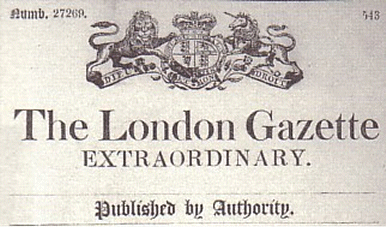
1665 The London Gazette, the oldest surviving journal, was first published.


680, The Sixth Ecumenical Council commenced in Constantinople.

1492 The Ensisheim Meteorite, the oldest meteorite with a known date of impact, struck the earth around noon in a wheat field outside the village of Ensisheim, Alsace, France.

1619 Elizabeth Stuart of Scotland and England was crowned Queen of Bohemia.

1665 The London Gazette, the oldest surviving journal, was first published.

Published on November 07, 2014 05:01
November 6, 2014
'Witch Marks' Carved Into 17th-Century Estate
Rossella Lorenzi
 English archaeologists have discovered "demon traps" under the floorboards of Knole, one of Britain's most important historic houses. The estate is shown here in the year 1800.
English archaeologists have discovered "demon traps" under the floorboards of Knole, one of Britain's most important historic houses. The estate is shown here in the year 1800.
Acquired by the Archbishops of Canterbury in the 15th century, gifted to Henry VIII and remodeled in the 17th century by the Sackville family, the house was the birthplace of poet and gardener Vita Sackville-West and the setting for Virginia Woolf's novel Orlando.

The so called witch marks emerged on beams and joists as archaeologists took up floorboards in the bed chamber prepared for King James I but also around the fireplace, considered a weak spot in the fight against witches and demons.
According to archaeologists from the Museum of London Archaeology (MOLA), the witch marks "illustrate how fear governed the everyday lives of people living through the tumultuous years of the early 17th century."

The marks date to early 1606 and the reign of King James I, a period when superstition and paranoia gripped England just after the failed Gunpowder Plot of 1605.
At that time, a handful of English Roman Catholic dissenters planned to blow up King James I of England and both Houses of Parliament.
Government propaganda, orchestrated by James I, blamed the Catholic conspirators as being in service to Satan, paving the way to widespread accusations of demonic forces and witches at work.

The researchers believe that craftsmen working for Thomas Sackville, who at that time owned Knole, carved the marks in anticipation of a visit from the King James I, with the intention of protecting him from evil spirits.
James himself had a keen interest in witchcraft and passed a witchcraft law, making it an offense punishable by death.
King Richard III Feasted on Wine and Swans
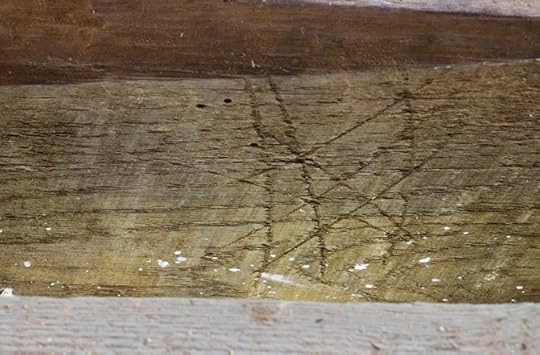
The carvings included criss-crossed lines, interlocking V-shapes to invoke the protection of the Virgin Mary, and scorch marks made by directly burning the timber with a candle.
They were intended to trap demons and witches at work.Discovery News

 English archaeologists have discovered "demon traps" under the floorboards of Knole, one of Britain's most important historic houses. The estate is shown here in the year 1800.
English archaeologists have discovered "demon traps" under the floorboards of Knole, one of Britain's most important historic houses. The estate is shown here in the year 1800.Acquired by the Archbishops of Canterbury in the 15th century, gifted to Henry VIII and remodeled in the 17th century by the Sackville family, the house was the birthplace of poet and gardener Vita Sackville-West and the setting for Virginia Woolf's novel Orlando.

The so called witch marks emerged on beams and joists as archaeologists took up floorboards in the bed chamber prepared for King James I but also around the fireplace, considered a weak spot in the fight against witches and demons.
According to archaeologists from the Museum of London Archaeology (MOLA), the witch marks "illustrate how fear governed the everyday lives of people living through the tumultuous years of the early 17th century."

The marks date to early 1606 and the reign of King James I, a period when superstition and paranoia gripped England just after the failed Gunpowder Plot of 1605.
At that time, a handful of English Roman Catholic dissenters planned to blow up King James I of England and both Houses of Parliament.
Government propaganda, orchestrated by James I, blamed the Catholic conspirators as being in service to Satan, paving the way to widespread accusations of demonic forces and witches at work.

The researchers believe that craftsmen working for Thomas Sackville, who at that time owned Knole, carved the marks in anticipation of a visit from the King James I, with the intention of protecting him from evil spirits.
James himself had a keen interest in witchcraft and passed a witchcraft law, making it an offense punishable by death.
King Richard III Feasted on Wine and Swans

The carvings included criss-crossed lines, interlocking V-shapes to invoke the protection of the Virgin Mary, and scorch marks made by directly burning the timber with a candle.
They were intended to trap demons and witches at work.Discovery News

Published on November 06, 2014 15:24
History Trivia - Treaty of Wallingford signed
November 6

355 Roman Emperor Constantius II promoted his cousin Julian to the rank of Caesar, entrusting him with the government of the Prefecture of the Gauls.
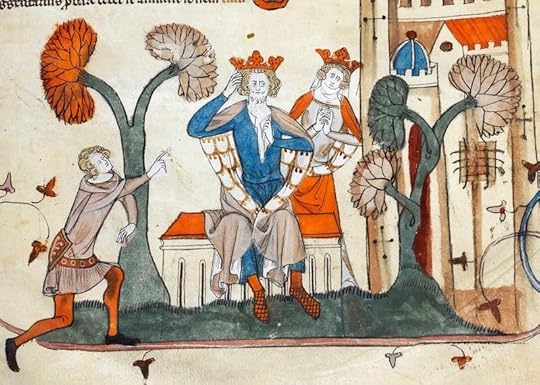
1153 Treaty of Wallingford was signed. This agreement effectively ended the civil war known as the Anarchy, caused by a dispute between Empress Matilda and her cousin King Stephen of England over the English crown. The Treaty of Wallingford forced Stephen to recognize Matilda's son Henry of Anjou, who became Henry II, as his heir, while Stephen kept the throne until he died.

1429 Henry VI was crowned King of England.


355 Roman Emperor Constantius II promoted his cousin Julian to the rank of Caesar, entrusting him with the government of the Prefecture of the Gauls.

1153 Treaty of Wallingford was signed. This agreement effectively ended the civil war known as the Anarchy, caused by a dispute between Empress Matilda and her cousin King Stephen of England over the English crown. The Treaty of Wallingford forced Stephen to recognize Matilda's son Henry of Anjou, who became Henry II, as his heir, while Stephen kept the throne until he died.

1429 Henry VI was crowned King of England.

Published on November 06, 2014 06:28
November 5, 2014
Booksessed: Review: Scribbler Tales by Mary Ann Bernal
Booksessed: Review: Scribbler Tales by Mary Ann Bernal: Book: The Scribbler Tales Volume 1 by Mary Ann Bernal Published by Whispering Legends Press; September 2014 45 pages Format: Ebook Genre...
Review: Scribbler Tales by Mary Ann Bernal
 Book: The Scribbler Tales Volume 1 by Mary Ann Bernal
Book: The Scribbler Tales Volume 1 by Mary Ann Bernal
Published by Whispering Legends Press; September 2014
45 pages
Format: Ebook
Genres: Short Stories
I got this book from the author in exchange for an honest review.
Synopsis via Goodreads: “Scribbler Tales is a unique mix of genres in one anthology rich with tension, humanity and genuine emotion. Unconventional settings and unexpected twists are bound to leave you pondering long after you close this book.”
In Desperate Measures, Audrey learns of Paul’s duplicity when human cloning experiments go awry. Forbidden Lore beckons Arianna and Ethan into a haunted cemetery where they are confronted by a gathering of witches with evil intent . Adrian must challenge his father to marry Rina or suffer the fate of star-crossed lovers in Forever Lost. In The Hourglass, Flair makes a covenant with the Devil to keep Brice alive. Aaron reflects upon his childhood as a military brat in Sail with Me.
My thoughts:
If you’ve been
reading a blog, you may have noticed that I am quite a fan of Mary Ann Bernal.
Whenever she has something new coming out, I don’t hesitate to hop on that
bandwagon and I am never sorry that I do. This trend continues with Scribbler
Tales.
Scribbler
Tales is a collection of 5 short stories of varying genres. Basically, if you
like short stories, regardless of your genre comfort zone, there is something in
Scribbler Tales that you will enjoy. (Though I dare you to not enjoy all five.
Seriously.)
My favorite story in
this first volume is Forever Lost. It’s one I had read before and it made me
realize why I love rereading; it’s like coming home to an old friend. Desperate
Measures might be my second favorite. It was not the type of story I would
expect from Mary Ann Bernal, and it blew me away! So creepy!
I think that
this collection really showcases her talent and diversity as a writer. Anyone
can make a decent story when they have hundreds of pages to play with, but to
create short stories that blow your mind in the few minutes it takes to read
them is a true challenge. A challenge that Mary Ann Bernal completes with ease.
I am eagerly awaiting the next volume of The Scribbler
Tales.

Review: Scribbler Tales by Mary Ann Bernal
 Book: The Scribbler Tales Volume 1 by Mary Ann Bernal
Book: The Scribbler Tales Volume 1 by Mary Ann BernalPublished by Whispering Legends Press; September 2014
45 pages
Format: Ebook
Genres: Short Stories
I got this book from the author in exchange for an honest review.
Synopsis via Goodreads: “Scribbler Tales is a unique mix of genres in one anthology rich with tension, humanity and genuine emotion. Unconventional settings and unexpected twists are bound to leave you pondering long after you close this book.”
In Desperate Measures, Audrey learns of Paul’s duplicity when human cloning experiments go awry. Forbidden Lore beckons Arianna and Ethan into a haunted cemetery where they are confronted by a gathering of witches with evil intent . Adrian must challenge his father to marry Rina or suffer the fate of star-crossed lovers in Forever Lost. In The Hourglass, Flair makes a covenant with the Devil to keep Brice alive. Aaron reflects upon his childhood as a military brat in Sail with Me.
My thoughts:
If you’ve been
reading a blog, you may have noticed that I am quite a fan of Mary Ann Bernal.
Whenever she has something new coming out, I don’t hesitate to hop on that
bandwagon and I am never sorry that I do. This trend continues with Scribbler
Tales.
Scribbler
Tales is a collection of 5 short stories of varying genres. Basically, if you
like short stories, regardless of your genre comfort zone, there is something in
Scribbler Tales that you will enjoy. (Though I dare you to not enjoy all five.
Seriously.)
My favorite story in
this first volume is Forever Lost. It’s one I had read before and it made me
realize why I love rereading; it’s like coming home to an old friend. Desperate
Measures might be my second favorite. It was not the type of story I would
expect from Mary Ann Bernal, and it blew me away! So creepy!
I think that
this collection really showcases her talent and diversity as a writer. Anyone
can make a decent story when they have hundreds of pages to play with, but to
create short stories that blow your mind in the few minutes it takes to read
them is a true challenge. A challenge that Mary Ann Bernal completes with ease.
I am eagerly awaiting the next volume of The Scribbler
Tales.

Published on November 05, 2014 13:55
Diane Turner - London Rocks - 05-11-2014
Published on November 05, 2014 13:19
History Trivia - Guy Fawkes Day
November 5

1219 The port of Damietta (Egypt) fell to the Crusaders after a siege.
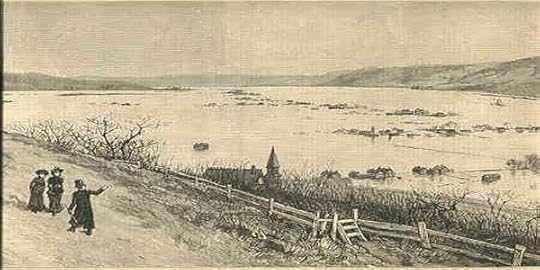
1530 St Felix Flood ravaged the Dutch coast, destroying the city of Reimerswaal in the Netherlands.
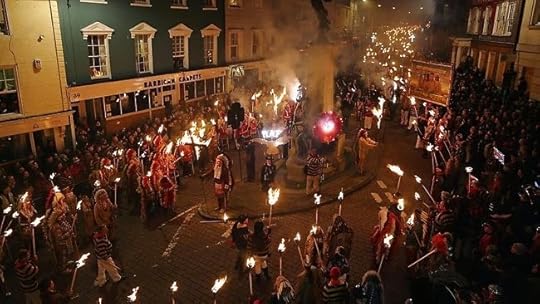
1605 Guy Fawkes Day, the Catholic convert conspired to blow up Parliament and the British royal family. The gunpowder plot was discovered and Fawkes was arrested before the event was to take place. Guy Fawkes Night, also known as Bonfire Night, is an annual celebration, primarily in Great Britain, traditionally and usually held on the evening of 5 November. Festivities are centered on the use of fireworks and the lighting of bonfires. It is also celebrated in former British Colonies such as Australia and New Zealand.


1219 The port of Damietta (Egypt) fell to the Crusaders after a siege.

1530 St Felix Flood ravaged the Dutch coast, destroying the city of Reimerswaal in the Netherlands.

1605 Guy Fawkes Day, the Catholic convert conspired to blow up Parliament and the British royal family. The gunpowder plot was discovered and Fawkes was arrested before the event was to take place. Guy Fawkes Night, also known as Bonfire Night, is an annual celebration, primarily in Great Britain, traditionally and usually held on the evening of 5 November. Festivities are centered on the use of fireworks and the lighting of bonfires. It is also celebrated in former British Colonies such as Australia and New Zealand.

Published on November 05, 2014 05:07
November 4, 2014
Illegal dig unearths ancient Egyptian temple
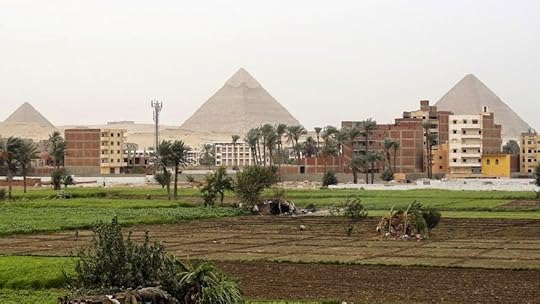 Seven men have been arrested in Egypt after digging up an ancient temple under a house in Giza, just outside Cairo.
Seven men have been arrested in Egypt after digging up an ancient temple under a house in Giza, just outside Cairo.Egyptian news website Ahram reports that the illegal excavation revealed the remains of a temple from the reign of Pharoah Tuthmose III.
The dig revealed huge limestone blocks covered in hieroglyphics, which belong to a massive temple, according to Egypt’s Antiquities Minister Mamdouh El-Damaty.
Ahram reports that two marble columns were also unearthed, along with seven reliefs and a large armless colossus of a seated person, made from red granite.
Major General Momtaz Fathi, an aide to the interior ministry and a director in Egypt’s tourism police, said that the find was made in mid October.
The arrests were made after Egypt’s tourism and antiquities police heard about the illegal excavation. Police found diving suits, diving masks and oxygen cylinders when they raided the dig, according to Ahram.
The unearthed artifacts were taken to the nearby archaeological site of Saqqara for restoration and further study. The Hod Zeleikha area of Giza where the illegal dig took place has now been declared an archaeological site, according to El-Damaty, who noted that more of the temple will be excavated.
Tuthmose III, known as “the Napoleon of ancient Egypt” as a result of his military successes, reigned from 1479 to 1425 B.C.
Located on the outskirts of Cairo, Giza is best known as the location of the Great Sphinx and the pyramids.
Fox News

Published on November 04, 2014 13:28
Wreck of 17th-Century Dutch Warship Discovered
by Megan Gannon
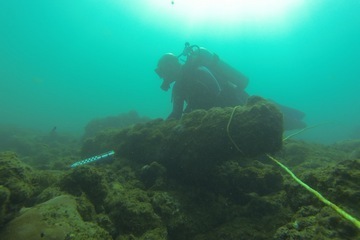
[image error] A diver measures a cannon found at the wreck site in Tobago's Rockley Bay.
Credit: Courtesy of the University of Connecticut
NEW YORK — The wreck of a 17th-century Dutch warship has been discovered off the coast of Tobago, a small island located in the southern Caribbean. Marine archaeologists believe the vessel is possibly the Huis de Kreuningen, which was lost during a bloody fight between Dutch and French colonists.
On March 3, 1677, the French Navy launched a fierce attack against the Dutch in Tobago's Rockley Bay. European settlers coveted Tobago for its strategic location; in fact, the island changed hands more than 30 times after Christopher Columbus arrived in the New World.
The abbreviated story of this particular battle is, "Everybody dies, and every ship sinks," according to Kroum Batchvarov, an assistant professor of maritime archaeology at the University of Connecticut. Indeed, about 2,000 people were killed and up to 14 ships went down during the skirmish. But until now, none of those sunken vessels had been recovered. [Shipwrecks Gallery: Secrets of the Deep]
This past March, Batchvarov went searching for wrecks in Rockley Bay. Through remote sensing and historical accounts, his team identified a spot where shipwrecks from the battle might have settled on the bottom of the bay. One day, while the rest of his colleagues were sorting out an issue with their GPS systems, Batchvarov and another diver decided to explore under the surface.
"Quite literally, the first thing we saw at the bottom was a cannon," Batchvarov told a small audience here at the Explorers Club headquarters today (Nov. 3).
During that initial, 20-minute dive, the researchers found at least seven cast-iron cannons, some of them large, 18-pounder guns.
"This was one of the most interesting experiences of my life in archaeology, and I have been in this field for about 17 years," Batchvarov said.
None of the sunken ship's timbers have been uncovered yet from the jumbled wreckage, but divers did find relics from life aboard a military vessel, including 72 clay smoking pipes, an array of dining utensils and burned bricks from the ship's galley. They also found a beer jug with three engravings of military generals from antiquity: Joshua, David and Alexander the Great.
Several clues led the team to conclude they were dealing with a Dutch warship from the 17th century. For example, many of the pipes had the mark of a manufacturer that operated in Amsterdam from the 1650s to the 1680s, Batchvarov said.
Because of the size of the cannons found at the site, the archaeologists suspect the wreck could be the 130-foot-long (40 meters), 56-gun warship Huis de Kreuningen. Only one other Dutch vessel, the flagship Bescherming, could have supported such large guns, but it survived the battle, Batchvarov said.
The French boarded the Huis de Kreuningen during the Battle of Tobago. To avoid capture, the Dutch captain, Roemer Vlacq, blew up the ship. The blaze spread and destroyed the French flagship Glorieux. Despite their major losses, the Dutch, led by commodore Jacob Binckes, were ultimately successful in holding back the French. (Years earlier, Binckes had re-captured New York for the Dutch; the city was, however, returned to England shortly after.)
Without proper conservation facilities nearby, the artifacts Batchvarov and his colleagues discovered had to be reburied underwater. But the project has just been awarded a grant from the U.S. State Department's Ambassadors Fund for Cultural Preservation so that the artifacts can be conserved and displayed in Trinidad and Tobago. Batchvarov and his colleagues plan to return to the site next year; their main goal is to establish the extent of the wreck.
Live Science


[image error] A diver measures a cannon found at the wreck site in Tobago's Rockley Bay.
Credit: Courtesy of the University of Connecticut
NEW YORK — The wreck of a 17th-century Dutch warship has been discovered off the coast of Tobago, a small island located in the southern Caribbean. Marine archaeologists believe the vessel is possibly the Huis de Kreuningen, which was lost during a bloody fight between Dutch and French colonists.
On March 3, 1677, the French Navy launched a fierce attack against the Dutch in Tobago's Rockley Bay. European settlers coveted Tobago for its strategic location; in fact, the island changed hands more than 30 times after Christopher Columbus arrived in the New World.
The abbreviated story of this particular battle is, "Everybody dies, and every ship sinks," according to Kroum Batchvarov, an assistant professor of maritime archaeology at the University of Connecticut. Indeed, about 2,000 people were killed and up to 14 ships went down during the skirmish. But until now, none of those sunken vessels had been recovered. [Shipwrecks Gallery: Secrets of the Deep]
This past March, Batchvarov went searching for wrecks in Rockley Bay. Through remote sensing and historical accounts, his team identified a spot where shipwrecks from the battle might have settled on the bottom of the bay. One day, while the rest of his colleagues were sorting out an issue with their GPS systems, Batchvarov and another diver decided to explore under the surface.
"Quite literally, the first thing we saw at the bottom was a cannon," Batchvarov told a small audience here at the Explorers Club headquarters today (Nov. 3).
During that initial, 20-minute dive, the researchers found at least seven cast-iron cannons, some of them large, 18-pounder guns.
"This was one of the most interesting experiences of my life in archaeology, and I have been in this field for about 17 years," Batchvarov said.
None of the sunken ship's timbers have been uncovered yet from the jumbled wreckage, but divers did find relics from life aboard a military vessel, including 72 clay smoking pipes, an array of dining utensils and burned bricks from the ship's galley. They also found a beer jug with three engravings of military generals from antiquity: Joshua, David and Alexander the Great.
Several clues led the team to conclude they were dealing with a Dutch warship from the 17th century. For example, many of the pipes had the mark of a manufacturer that operated in Amsterdam from the 1650s to the 1680s, Batchvarov said.
Because of the size of the cannons found at the site, the archaeologists suspect the wreck could be the 130-foot-long (40 meters), 56-gun warship Huis de Kreuningen. Only one other Dutch vessel, the flagship Bescherming, could have supported such large guns, but it survived the battle, Batchvarov said.
The French boarded the Huis de Kreuningen during the Battle of Tobago. To avoid capture, the Dutch captain, Roemer Vlacq, blew up the ship. The blaze spread and destroyed the French flagship Glorieux. Despite their major losses, the Dutch, led by commodore Jacob Binckes, were ultimately successful in holding back the French. (Years earlier, Binckes had re-captured New York for the Dutch; the city was, however, returned to England shortly after.)
Without proper conservation facilities nearby, the artifacts Batchvarov and his colleagues discovered had to be reburied underwater. But the project has just been awarded a grant from the U.S. State Department's Ambassadors Fund for Cultural Preservation so that the artifacts can be conserved and displayed in Trinidad and Tobago. Batchvarov and his colleagues plan to return to the site next year; their main goal is to establish the extent of the wreck.
Live Science

Published on November 04, 2014 13:22
History Trivia - Joan of Arc liberates Saint-Pierre-le-Moûtier.
November 4

1333 The River Arno flooding caused massive damage in Florence as recorded by the Florentine chronicler Giovanni Villani.

1429 Joan of Arc liberated Saint-Pierre-le-Moûtier.

1501 Catherine of Aragon (later Henry VIII's first wife) met Arthur Tudor, Henry VIII's older brother – they would later marry.

1520 Christian II Crowned King of Sweden. Already king of Denmark and Norway, Christian conquered Sweden as well. But the subsequent massacre of his opponents led to a Swedish war of liberation, which was achieved a mere three years later.

1529 English Cardinal Thomas Wolsey was arrested. Wolsey's failure to secure the annulment for Henry VIII from Catherine of Aragon is widely perceived to have directly caused his downfall and arrest.


1333 The River Arno flooding caused massive damage in Florence as recorded by the Florentine chronicler Giovanni Villani.

1429 Joan of Arc liberated Saint-Pierre-le-Moûtier.

1501 Catherine of Aragon (later Henry VIII's first wife) met Arthur Tudor, Henry VIII's older brother – they would later marry.

1520 Christian II Crowned King of Sweden. Already king of Denmark and Norway, Christian conquered Sweden as well. But the subsequent massacre of his opponents led to a Swedish war of liberation, which was achieved a mere three years later.

1529 English Cardinal Thomas Wolsey was arrested. Wolsey's failure to secure the annulment for Henry VIII from Catherine of Aragon is widely perceived to have directly caused his downfall and arrest.

Published on November 04, 2014 04:19




